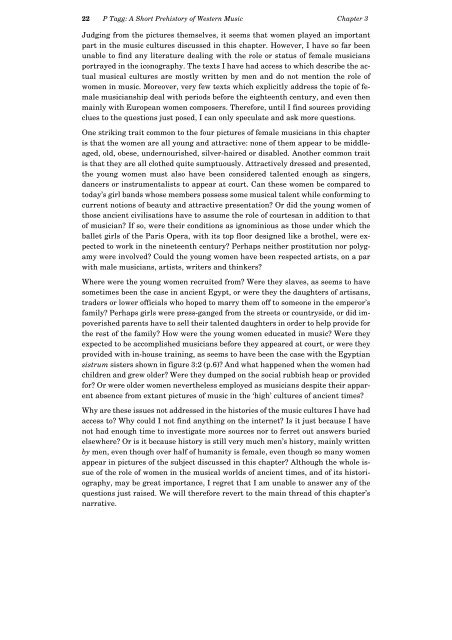A Short Prehistory of Western Music, Chapter 3
A Short Prehistory of Western Music, Chapter 3
A Short Prehistory of Western Music, Chapter 3
Create successful ePaper yourself
Turn your PDF publications into a flip-book with our unique Google optimized e-Paper software.
22 P Tagg: A <strong>Short</strong> <strong>Prehistory</strong> <strong>of</strong> <strong>Western</strong> <strong>Music</strong> <strong>Chapter</strong> 3<br />
Judging from the pictures themselves, it seems that women played an important<br />
part in the music cultures discussed in this chapter. However, I have so far been<br />
unable to find any literature dealing with the role or status <strong>of</strong> female musicians<br />
portrayed in the iconography. The texts I have had access to which describe the actual<br />
musical cultures are mostly written by men and do not mention the role <strong>of</strong><br />
women in music. Moreover, very few texts which explicitly address the topic <strong>of</strong> female<br />
musicianship deal with periods before the eighteenth century, and even then<br />
mainly with European women composers. Therefore, until I find sources providing<br />
clues to the questions just posed, I can only speculate and ask more questions.<br />
One striking trait common to the four pictures <strong>of</strong> female musicians in this chapter<br />
is that the women are all young and attractive: none <strong>of</strong> them appear to be middleaged,<br />
old, obese, undernourished, silver-haired or disabled. Another common trait<br />
is that they are all clothed quite sumptuously. Attractively dressed and presented,<br />
the young women must also have been considered talented enough as singers,<br />
dancers or instrumentalists to appear at court. Can these women be compared to<br />
today’s girl bands whose members possess some musical talent while conforming to<br />
current notions <strong>of</strong> beauty and attractive presentation? Or did the young women <strong>of</strong><br />
those ancient civilisations have to assume the role <strong>of</strong> courtesan in addition to that<br />
<strong>of</strong> musician? If so, were their conditions as ignominious as those under which the<br />
ballet girls <strong>of</strong> the Paris Opera, with its top floor designed like a brothel, were expected<br />
to work in the nineteenth century? Perhaps neither prostitution nor polygamy<br />
were involved? Could the young women have been respected artists, on a par<br />
with male musicians, artists, writers and thinkers?<br />
Where were the young women recruited from? Were they slaves, as seems to have<br />
sometimes been the case in ancient Egypt, or were they the daughters <strong>of</strong> artisans,<br />
traders or lower <strong>of</strong>ficials who hoped to marry them <strong>of</strong>f to someone in the emperor’s<br />
family? Perhaps girls were press-ganged from the streets or countryside, or did impoverished<br />
parents have to sell their talented daughters in order to help provide for<br />
the rest <strong>of</strong> the family? How were the young women educated in music? Were they<br />
expected to be accomplished musicians before they appeared at court, or were they<br />
provided with in-house training, as seems to have been the case with the Egyptian<br />
sistrum sisters shown in figure 3:2 (p.6)? And what happened when the women had<br />
children and grew older? Were they dumped on the social rubbish heap or provided<br />
for? Or were older women nevertheless employed as musicians despite their apparent<br />
absence from extant pictures <strong>of</strong> music in the ‘high’ cultures <strong>of</strong> ancient times?<br />
Why are these issues not addressed in the histories <strong>of</strong> the music cultures I have had<br />
access to? Why could I not find anything on the internet? Is it just because I have<br />
not had enough time to investigate more sources nor to ferret out answers buried<br />
elsewhere? Or is it because history is still very much men’s history, mainly written<br />
by men, even though over half <strong>of</strong> humanity is female, even though so many women<br />
appear in pictures <strong>of</strong> the subject discussed in this chapter? Although the whole issue<br />
<strong>of</strong> the role <strong>of</strong> women in the musical worlds <strong>of</strong> ancient times, and <strong>of</strong> its historiography,<br />
may be great importance, I regret that I am unable to answer any <strong>of</strong> the<br />
questions just raised. We will therefore revert to the main thread <strong>of</strong> this chapter’s<br />
narrative.














